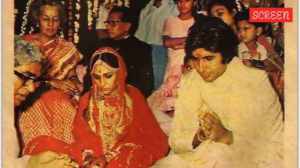The Body in Depth
An amazing atlas of the human body will go online

An amazing atlas of the human body will go online
Roberta Corson recalled her father’s dissection lab as a happy place. Her father, David L. Bassett, was an expert in anatomy and dissection at the University of Washington. For more than 17 years, he was engaged in creating what has been called the most painstaking and detailed set of images of the human body, inside and out, ever produced. In 3-D.
Working closely with William Gruber, the inventor of the View-Master, the three-dimensional viewing system, Bassett created the 25-volume “Stereoscopic Atlas of Human Anatomy” in 1962. It included some 1,500 pairs of slides, along with line drawings that made the details more discernible. The paired slides could be examined with a View-Master, making the chest cavity look cavernous, and making details of structure and tissue stand out unforgettably.
The atlas was an immediate success and the images became an important resource for medical students, even more so as schools have de-emphasised gross anatomy and cadaver work. But the atlas eventually went out of publication in the 1960s.
Thanks to Stanford University’s school of medicine, however, the work will soon be available to the world. The school is bringing the images online.
Even without the stereoscopic boost, the images are stunning, though perhaps not best examined over breakfast. Blood vessels cluster in a cobwebby tangle along a spinal column, and pelvic bones stand out like butterflies against a stark black field. The back of a man’s head, its layers of flesh and bone sliced away, shows the excavation from the scalp down to the brain as if looking at a stratified canyon wall. The original Kodachrome slides, carefully preserved, still provide images of tremendous clarity.
Looking at the images today is a little like viewing the “Body Worlds” exhibition but without unsettling concerns about the exact provenance of the bodies. Critics and the exhibitors give different accounts of where the bodies came from. It is quite clear that Bassett’s cadavers were people who had willed their bodies to science.
It was the close collaboration of two very different men that made possible the creation of the collection. Bassett was an academic and an anatomist, a gregarious man with a great talent for dissection. His daughter recalls that his fingers were so nimble and precise that he once caught a fish with his bare hands.
Gruber was a former pipe organ maker from Germany; his interest in photography and stereography had led him to create the View-Master, an invention that made him wealthy enough to take on projects simply because they fascinated him. And he chose corpses, formaldehyde and the dissecting skills of Bassett.
By using embalmed bodies, Bassett and Gruber reasoned, they could work with better preserved tissues. Bassett had devised his own embalming fluid that would retain “near normal color” of the tissue. He began the great work of his life with the head and neck. “I certainly grew up around bodies, and his dissections,” Corson said—along with her three brothers. “There was nothing gross or ugly about it. It was beautiful.”
Gruber’s visits were frequent; Bassett would prepare the specimens, and Gruber would arrive for a three-day visit, staying at the Bassett home. Bassett would perform the dissections, and Gruber would shoot from the slightly different angles that provided stereoscopic viewing. They worked into the night.
The images, when presented to the medical profession, were a sensation. The work was completed by 1962, with the 25 volumes packed with thousands of pictures and diagrams, and hundreds of View-Master reels. That year, Gruber wrote to Bassett to congratulate him on having finished the project, saying: “No one outside of Lucile and myself will ever know what torturous 10 years of slavery you went through to reach the top. Let me add my prayer and hope that you will not have to die to earn your just recognition.”
-JOHN SCHWARTZ (New York Times)


- 01
- 02
- 03
- 04
- 05





























